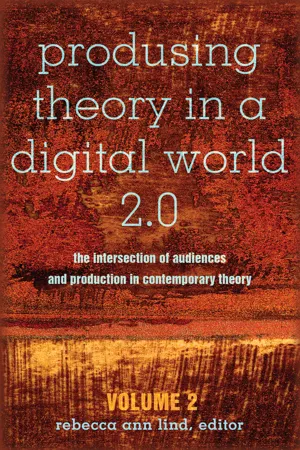
Produsing Theory in a Digital World 2.0
The Intersection of Audiences and Production in Contemporary Theory Volume 2
- 299 pages
- English
- PDF
- Available on iOS & Android
Produsing Theory in a Digital World 2.0
The Intersection of Audiences and Production in Contemporary Theory Volume 2
About this book
Continuing the explorations begun in the first Produsing Theory volume, this book provides a site at which varied theories – some still emerging – can intersect and shine a light into the spaces between what previously had been neatly separated and discrete components of media systems. In some settings, division by audience, content, and production settings remains useful, but this volume, like the first, is all about the interstices.
Contributors reflect varied perspectives in their approaches to the spaces formed as a result of rapidly developing and swiftly deploying new communications technologies and social software. They shine multiple spotlights into the intersection of audiences and production, providing a guide toward a nuanced understanding of the interstitial spaces.
Frequently asked questions
- Essential is ideal for learners and professionals who enjoy exploring a wide range of subjects. Access the Essential Library with 800,000+ trusted titles and best-sellers across business, personal growth, and the humanities. Includes unlimited reading time and Standard Read Aloud voice.
- Complete: Perfect for advanced learners and researchers needing full, unrestricted access. Unlock 1.4M+ books across hundreds of subjects, including academic and specialized titles. The Complete Plan also includes advanced features like Premium Read Aloud and Research Assistant.
Please note we cannot support devices running on iOS 13 and Android 7 or earlier. Learn more about using the app.
Information
Table of contents
- Cover
- Contents
- Acknowledgments
- Chapter One: Produsing Theory in a Digital World: Life in the Interstices (Rebecca Ann Lind)
- Chapter Two: The Interpretive Community Redux: The Once and Future Saga of a Media Studies Concept (Thomas R. Lindlof)
- Chapter Three: Duality Squared: On Structuration of Internet Governance (Dmitry Epstein)
- Chapter Four: Produsing the Hidden: Darknet Consummativities (Jeremy Hunsinger)
- Chapter Five: Online Performative Identity Theory: A Preliminary Model for Social Media’s Impact on Adolescent Identity Formation (Bradley W. Gorham, Jaime R. Riccio)
- Chapter Six: Understanding the Popularity of Social Media: Flow Theory, Optimal Experience, and Public Media Engagement (John V. Pavlik)
- Chapter Seven: “For this much work, I need a Guild card!”: Video Gameplay as a (Demanding) Coproduction (Nicholas David Bowman)
- Chapter Eight: The Mobile Conversion, Internet Regression, and the Repassification of the Media Audience (Philip M. Napoli, Jonathan A. Obar)
- Chapter Nine: Social Media Audience Metrics as a New Form of TV Audience Measurement (Darryl Woodford, Ben Goldsmith, Axel Bruns)
- Chapter Ten: Staging the Subaltern Self and the Subaltern Other: Digital Labor and Digital Leisure in ICT4D (Radhika Gajjala, Dinah Tetteh, Anca Birzescu)
- Chapter Eleven: Race, Gender, and Virtual Inequality: Exploring the Liberatory Potential of Black Cyberfeminist Theory (Kishonna L. Gray)
- Chapter Twelve: Digital Human Rights Reporting by Civilian Witnesses: Surmounting the Verification Barrier (Ella McPherson)
- Chapter Thirteen: Twitter as a Pedagogical Tool in Higher Education (Renee Hobbs)
- Chapter Fourteen: Engaging Adolescents in Narrative Research and Interventions on Cyberbullying (Heidi Vandebosch, Philippe C. G. Adam, Kath Albury, Sara Bastiaensens, John de Wit, Stephanie Hemelryk Donald, Kathleen Van Royen, Anne Vermeulen)
- Chapter Fifteen: Produsing Ethics [for the Digital Near Future] (Annette N. Markham)
- Chapter Sixteen: Afterword: What’s So New About New Media? (Dennis K. Davis)
- Contributors
- Index